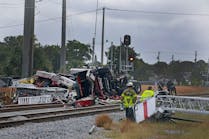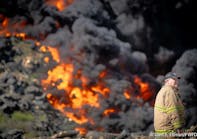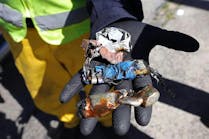TOPIC: BACK TO BASICS: EFFECTIVE VENTILATION
TIME REQUIRED: THREE HOURS
MATERIALS: ACQUIRED STRUCTURE OR VENTILATION PROPS, VARIOUS HAND AND POWER TOOLS, VENTILATION EQUIPMENT , SMOKE GENERATION EQUIPMENT
REFERENCES: ESSENTIALS OF FIRE FIGHTING, FOURTH EDITION, IFSTA, CHAPTER 10
PREPARATION:
MOTIVATION: Ventilation is an essential element of almost any firefighting operation. Removal of smoke, heat, and hot gases can make is easier to see potential victims, reduce potential harm to victims, reduce the stress to firefighters, and assist with fire control and extinguishment.
OBJECTIVE (SPO): The student will demonstrate a basic understanding of the methods and techniques of ventilation by applying those ventilation methods and techniques in a practical setting.
OVERVIEW:
Effective Ventilation
* Ventilation theory
* Ventilation techniques in various structures
* Horizontal ventilation practical
* Vertical ventilation practical
EFFECTIVE VENTILATION
SPO The student will demonstrate a basic understanding of the methods and techniques of ventilation by applying those ventilation methods and techniques in a practical setting.
EO 1-1 Explain horizontal and vertical and natural and forced ventilation.
EO 1-2 Describe ventilation techniques in various types of structures.
EO 1-3 Demonstrate the proper procedure for placing fans and blowers for positive and negative pressure ventilation in a door or window.
EO 1-4 Demonstrate the proper use of various hand and power tools to force entry through a roof for ventilation.
The purpose of this drill is to review and build on basic skills with the emphasis on improving efficiency and teamwork. It is assumed that the participants have some basic knowledge of the subject matter. The focus of the drill should include personal and team safety. The drill should include minimal instruction and maximum skills practice. The drill should also be conducted with the normal staffing that would respond on an engine, truck, or squad on a structure assignment.
I. VENTILATION THEORY (1-2)
A. Ventilation Techniques and Theory
1. Hot air rises using the path of least resistance and spreads or mushrooms out and downward
2. Natural ventilation utilizes existing opening such as windows and roof openings
3. Mechanical ventilation utilizes smoke ejectors or blowers
4. Hydraulic ventilation utilizes nozzles and water flow air currents
5. Ventilation requires the movement of air which means that there must be air containing smoke, heat, and gases being removed with the replacement of fresh air
B. Importance and Timing of Ventilation
1. Coordinate with fire attack since the increase in air flow will accelerate burning
2. Ventilation removes smoke and heat and increases visibility
C. Horizontal Ventilation
1. Windows
a. When time and conditions permits, windows should be opened rather than broken out (it may be better to remove a window to relieve heat and smoke rather than leave them in place for positive pressure ventilation, especially when there is a known rescue)
b. Double hung windows should be opened one-half down from the top and one-third up from the bottom (textbooks say two-thirds but there are only two sections in most double hung windows and they will only open half way)
c. Open other types of windows as much as possible
d. Storm windows must also be opened or removed
e. Shades, blinds, drapes, curtains, and other window coverings must be moved away or removed to avoid obstructing air flow
f. When wind is a factor, windows on leeward side should be opened first
2. Window and roof ventilation
a. When roof or roof features must be opened for venting, windows on top floor should be opened
b. If windows on several floors must be opened, begin on top and work down
c. Opening windows from below first may cause fire and smoke spread
3. Smoke ejectors
a. Cannot be used as a substitute for natural ventilation techniques
1) Fans should not be used in partially or completely confined spaces in which there is fire
2) May be used in confined areas after fire has been knocked down
b. Fan placement
1) Most effective when placed where they tend to increase natural air flow
2) When fans are positioned in windows or doorways, all shades, drapes, blinds, curtains, and screens should be removed
3) If possible, open area around fan should be closed to increase fan efficiency by directing air through opening and preventing smoke from re-entering (churning of air)
4) Be careful not to exhaust smoke into congested areas or into heating and cooling intakes
5) Fan can be hung in windows or on doors, in doorways using compression devices, or on the underside of ladders
c. Fans in tandem
1) Can be especially effective when used in pairs
2) Place one fan near an outside opening blowing smoke out and the other fan inside room to blow smoke to first fan
3) Fans can be used to exhaust smoke and draw in fresh air at same time
4) Exhaust fan should be mounted high in vent opening
5) Intake fan should be lower
4. Positive pressure blowers
a. Introduction
1) Fresh air introduced to increase pressure
2) Selective process of opening and closing doors and windows - effective on all structures when doors and windows maintained
3) Initiated outside structure
4) Has potential of moving fire and fire gases
5) Generally speaking, initiated between fire fighters and fire or between fire and trapped victims
6) Can maintain primary and secondary egress routes
7) Quicker than negative ventilation
8) Works well in large areas
b. Blower placement
1) Place fan far enough away from door to fill opening with cone of air
2) Stacking fans increases volume greatly
3) For oversized doors, place fans side by side or in tandem
4) For single fan, place 6’ to 10' from doorway
5) For multiple fans, place the first blower 3’ to 5' from doorway (if different size blowers, place the larger blower in front)
5. Fog streams
a. Can be used to start venting immediately after fire has been knocked down
b. To be most effective, stream should be positioned so fog pattern covers most of window opening
c. Hold nozzle two feet inside window
d. Observe smoke movement to determine proper position of nozzle
e. Fog streams should not be used for venting if they damage
1) Items removed for protection
2) Outside of fire building or enter adjourning buildings
3) Inside of room from which directed
f. They should not cause ice to form outside
g. Should be short term operation
D. Vertical Ventilation
NOTE: Ladders should be used to provide safer footing for any pitched roof operation and to spread the load on any flat room. There should always be two means of escape for any roof operation and a protection hoseline should be in place on the roof. Roofs should also be checked to make sure they are safe to work on. Spongy material, bubbling tar, melted snow or dry spots on a roof, or smoke or heat emitting from the roof are some of the signs that the integrity of the roof may be compromised.
1. Natural Roof Openings
a. In multi-story buildings, vertical shafts which extend the full height of the building carry stairways, elevators, dumbwaiters, electric wiring, heating ducts, and plumbing and sewer pipes
b. Convected heat, smoke, and gases will rise within and around shafts
c. If shafts are not vented at top, fire will travel horizontally
d. Pressure will force heat, smoke, and gases throughout upper part of building
e. Shafts are capped at roof with various closures (make sure of area being vented when cap is removed)
2. Cutting Through Roofs
a. At times, only way to properly ventilate is cut hole in roof
1) Roof made of boards can be cut with axe
2) Roof may of plywood should be cut with circular or chain power saw
3) Care should be taken not to cut joists or other structural members
b. Single large hole is more effective than several small holes
1) One 4' X 4' hole has twice area of four 2' X 2' holes
2) All roof boards should be cut through before any pulled up
3) Keep back to wind when pulling boards
4) When all boards ripped up, make opening in ceiling below
c. Special care should be taken when fire is immediately below roof
1) Open roof as close as possible to seat of fire so that fire will be drawn across top of building to opening
2) Hot spots may develop on roof
3) If roof is flat, opening should be made at hot spot
4) On gabled roof, opening should extend from hot spot to peak
5) Draft can be increased by making an additional opening just above the eave line on side opposite original opening
6) Care should be taken so that opening does not increase fire spread
3. Trench cut
a. Used to stop the spread of fire in a long, narrow structure
b. Performed by cutting a large hole or trench that is at least four feet wide
c. Trench extends from one exterior wall to the other
d. Usually cut well ahead of the advancing fire to set up a defensive line
4. Construction features (roof vents, ridge vents, etc.)
a. May be easily removed to ventilate structure
b. May cause less damage
c. Need to determine what areas are being ventilated in the event shafts extend into occupied areas and do not ventilate spaces between ceiling and roof
d. Vents at the end of a roof may be used to ventilate areas where there is no air space between the ceiling and the roof
II. VENTILATION TECHNIQUES IN VARIOUS STRUCTURES (1-2)
NOTE: Remove smoke using closest exit point rather than passing it through an unaffected area.
A. One-Story Dwellings
1. Open or remove windows close to fire
2. First windows to be opened are those through which fire or smoke is pushing out or through which fire can be seen or heard
3. Other windows should be opened to complete ventilation
4. Attic or cockloft should be checked for fire spread, especially area over fire
B. Two-Story Dwellings
1. For fires on first floor, first floor windows closest to fire should be opened immediately
2. Second floor should be vented as soon as possible
3. For fire on second floor, floor must be vented first
4. Start by venting outside and move inside
5. Check attic or cockloft for fire - especially important where units are side by side
C. Attic Fires
1. Attack fire from inside structure rather than through windows
2. Attic can be ventilated using windows or louvers
3. If necessary, open roof near peak over hot spots
D. Basement Fires
1. Fires in small dwellings should be vented through all available basement openings
2. Venting should be coordinated with attack lines
3. Attack lines should be taken through both outside basement entrance and first floor basement entrance
4. If attack is through only one entrance, other available openings can be used for venting
5. Venting first floor can assist in positioning and advancing lines
E. Multiple-Use Residential and Business Buildings
1. Roof operations
a. Should not use interior stairs for access
b. Use interior stairs of building when it abuts fire building
c. Use fire escape of fire building if it has roof access
d. If no other way, use ground ladders or aerial unit
e. Ladder should remain in place until crew leaves roof
f. If visibility is poor, crew should probe roof with tools before stepping onto it
g. Crews should immediately look for another way off roof in case of emergency
2. Venting
a. Roof venting should be done with available natural openings if possible
b. Roof features showing smoke should be opened first
c. Skylights, scuttles, and penthouses should then be quickly opened
d. Tops of vertical shafts should be checked and opened if needed
e. Once roof has been vented, top floor should be opened from exterior or interior
f. Should not attempt to enter top floor from roof if heavily charged with smoke - open windows from aerial ladder or platform
g. Ground ladders can be used to knock out top floor windows on shorter buildings
h. Floor just above fire floor must be thoroughly vented
i. Fire floor must be vented to allow advancing of hoselines and search for victims
3. Ground-floor stores
a. Vent roof, top floor, and floor above fire
b. Vent store thoroughly
c. Open utility shafts to deter fire spread
4. Adjoining buildings
a. Adjoining buildings should be vented and cocklofts checked for extending fire
b. Vent through skylights, scuttles, and penthouse to keep damage to minimum
c. If cockloft is not vented when skylights or scuttles are opened, the boxed area below them will have to be opened
d. Exposure fire should be completely vented with a roof opening over the hot spot
F. Shopping Centers, Row Stores, and Other One-story Buildings
1. Roof operations
a. Assume no fire walls between stores or building sections
b. Roof should be opened for venting first
c. Use natural roof features for first opening only if close enough to hot spot
d. If natural roof feature not close enough, cut opening over or near hot spot
e. After making one opening over main body of fire, natural openings can be used
f. Roof venting operations must be effective because buildings are practically windowless
g. Be aware of roof areas which might be particularly hazardous
h. Steel roof girders and joists are exposed to heat from below with no protective layer between steel and heat of fire
i. Avoid areas if roof is spongy or sagging
2. Attached occupancies
a. Once fire building roof is properly opened, roofs of attached buildings should be opened through natural roof features
1) Determine whether fire has spread
2) Allow accumulated gases to escape
b. If fire is found in attached exposure, roof should be opened over fire
3. Ground-level ventilation
a. When necessary, store can be ventilated through front display windows and through rear windows and doors
b. Window lights may be easier to remove
G. Basement Fires in Large Structures
1. Basement venting
a. Any opening into basement can be used for venting
1) If possible, ventilation openings should be away from those being used for fire attack
2) If single entrance, ventilate though basement windows
3) With single entrance, if fire is extinguished quickly, venting first floor may suffice to clear basement
4) First floor should be cut to open it to basement just inside front window if first floor venting does not suffice
5) Open front window on first floor to remove or draw smoke and gases from basement
6) For basement windows below ground level, knock out glass and remove grates if needed
b. Storefront walls
1) If no basement windows or doors in front of fire building, open low wall below display window to vent basement
2) Knock out display window before opening low wall - procedure used depends on material involved
3) Basement ceiling may need to be removed
4) May need to open display window floor to vent
5) If store has two display windows, both display window walls or floors should be opened
c. Other openings - any opening that will help ventilate basement should be used to permit fire attack and lessen chance of fire spread
2. First-floor venting
a. Vent through windows to remove products of combustion
b. Venting increases effectiveness of search and reduces change of fire spread
3. Roof venting
a. Shafts running through building must be opened at roof
b. Helps vent basement and prevents smoke accumulation and ignition of upper part of building
H. Fire Resistant Structures - cannot be vented in same way as more standard structures
1. Window venting
a. Best way to ventilate
b. Prop doors open and open as many windows as possible on both sides of corridor
c. If necessary, smoke ejectors can aid in ventilation
e. As soon thereafter as possible, vent floor above fire and search for victims
f. Hose lines should be advanced to floor above fire to keep fire from extending vertically
2. Stairway venting
a. If building is unoccupied or completely evacuated, doors from corridors to stairways can be opened
b. Stairway shafts will draw smoke from corridors and provide vertical venting
c. Remove heat and smoke as quickly as possible to relieve physical strain on engine crews
III. HORIZONTAL VENTILATION PRACTICAL (1-3)
NOTE: Review the skills and techniques covered in the Fire Fighter I program. This section should be an opportunity to practice previously learned skills rather than a session where new skills are learned.
A. Full protective clothing including eye protection is required for this section.
B. It may be appropriate to review the handling, use, and operation of the tools to be used prior to any student demonstrations.
C. Demonstrate the proper procedure for placing fans and blowers for positive and negative pressure ventilation in a door or window
D. Demonstrate the proper procedure for placing a hoseline for hydraulic ventilation at a window
IV. VERTICAL VENTILATION PRACTICAL (1-4)
NOTE: Review the skills and techniques covered in the Fire Fighter I program. This section should be an opportunity to practice previously learned skills rather than a session where new skills are learned.
A. Full protective clothing including eye protection is required for this section.
B. It may be appropriate to review the handling, use, and operation of the tools to be used prior to any student demonstrations.
C. Demonstrate the proper use of various hand and power tools to force entry through various roof materials for ventilation.
REVIEW:
Ventilation techniques and skills are something that should be practiced on a regular basis so that the firefighters will be able to perform them quickly when needed. This is especially true when it comes to the operation of power tools and the use of hand tools. The training should also be as realistic as possible since working on a slopped roof presents challenges that are not present when cutting wood pallets or similar material at ground level.
Effective Ventilation
* Ventilation theory
* Ventilation techniques in various structures
* Horizontal ventilation practical
* Vertical ventilation practical






